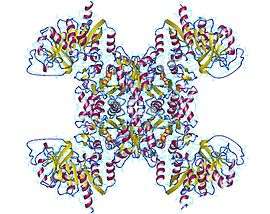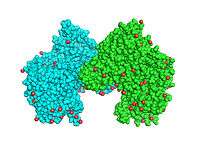CTP synthetase
| CTP synthetase | |||||||||
|---|---|---|---|---|---|---|---|---|---|
 | |||||||||
| Identifiers | |||||||||
| EC number | 6.3.4.2 | ||||||||
| CAS number | 9023-56-7 | ||||||||
| Databases | |||||||||
| IntEnz | IntEnz view | ||||||||
| BRENDA | BRENDA entry | ||||||||
| ExPASy | NiceZyme view | ||||||||
| KEGG | KEGG entry | ||||||||
| MetaCyc | metabolic pathway | ||||||||
| PRIAM | profile | ||||||||
| PDB structures | RCSB PDB PDBe PDBsum | ||||||||
| Gene Ontology | AmiGO / EGO | ||||||||
| |||||||||
CTP synthetase is an enzyme involved in pyrimidine biosynthesis that interconverts UTP and CTP.[1][2]
Reaction mechanism
CTP (cytidine triphosphate) synthetase catalyzes the last committed step in pyrimidine nucleotide biosynthesis:[3]
ATP + UTP + glutamine → ADP + Pi + CTP + glutamate
It is the rate-limiting enzyme for the synthesis of cytosine nucleotides from both the de novo and uridine salvage pathways.[4]
The reaction proceeds by the ATP-dependent phosphorylation of UTP on the 4-oxygen atom, making the 4-carbon electrophilic and vulnerable to reaction with ammonia.[5] The source of the amino group in CTP is glutamine, which is hydrolysed in a glutamine amidotransferase domain to produce ammonia. This is then channeled through the interior of the enzyme to the synthetase domain.[6][7] Here, ammonia reacts with the intermediate 4-phosphoryl UTP.[8]

Isozymes
Two isozymes with CTP synthase activity exist in humans, encoded by the following genes:
Structure

Active CTP synthase exists as a homotetrameric enzyme. At low enzyme concentrations and in the absence of ATP and UTP, CTP synthase exists as inactive monomer. As enzyme concentration increases, it polymerizes first to a dimer (such as the form shown to the left) and, in the presence of ATP and UTP, forms a tetramer.[5][9]
The enzyme contains two major domains, responsible for the aminotransferase and synthase activity, respectively. The amidotransferase domains are located away from the tetramer interfaces and are not affected by the oligomeric state. The ATP-binding site and CTP-binding site in the synthase domain are located at the tetramer interface. It is for this reason that ATP and UTP are required for tetramerization.[10]
Regulation
CTP synthase is precisely regulated by the intracellular concentrations of CTP and UTP, and both hCTPS1 and hCTPS2 have been seen to be maximally active at physiological concentrations of ATP, GTP, and glutamine.[11]
The activity of human CTPS1 isozyme has been demonstrated to be inhibited by phosphorylation.[12] One major example of this is phosphorylation of the Ser-571 residue by glycogen synthase kinase 3 (GSK3) in response to low serum conditions.[13] Additionally, Ser568 has been seen to be phosphorylated by casein kinase 1, inhibiting CTP synthase activity.[11]
CTP is also subject to various forms of allosteric regulation. GTP acts as an allosteric activator that strongly promotes the hydrolysis of glutamine, but is also inhibiting to glutamine-dependent CTP formation at high concentrations.[14] This acts to balance the relative amounts of purine and pyrimidine nucleotides. The reaction product CTP also serves as an allosteric inhibitor. The triphosphate binding site overlaps with that of UTP, but the nucleoside moiety of CTP binds in an alternative pocket opposite the binding site for UTP.[15]
The glutamine analog DON has also been seen to act as an irreversible inhibitor, and has been used as an anti-cancer agent.[16]
Filaments
CTP synthase has been reported to form filaments in several different organisms. These include bacteria (C. crescentus),[17] yeast (S. cerevisiae),[18] fruit flies (D. melanogaster)[19] and human cells.[20] These filamentous structures have been referred to as cytoplasmic rods and rings,[21] cytoophidia (from the Greek "cyto" meaning cell and "ophidium" meaning serpent, due to the structures morphology) or simply CTP synthase filaments. It has been shown that filamentation downregulates CTP synthase activity.[22][23][24][25] In Drosophila, only one of the CTP synthase isoform forms the filament[26]
Clinical significance
Upregulated CTP synthase activity has been widely seen in human and rodent tumors.[27]
Mutations in the CTP synthase have been seen to confer resistance to cytotoxic drugs such as cytosine arabinoside (ara-C) in a Chinese hamster ovary (CHO) cell model of leukemia though such mutations were not found in human patients with ara-C resistance.[28]
See also
References
- ↑ Lieberman I (1956). "Enzymatic amination of uridine triphosphate to cytidine triphosphate". The Journal of Biological Chemistry. 222 (2): 765–75. PMID 13367044.
- ↑ Long CW, Levitzki A, Koshland DE (1970). "The subunit structure and subunit interactions of cytidine triphosphate synthetase". The Journal of Biological Chemistry. 245 (1): 80–7. PMID 5411547.
- ↑ Koshland, D. E.; Levitzki, A. (1974). "CTP Synthetase and Related Enzymes". In Boyer, Paul D. The Enzymes (3rd ed.). New York: Academic Press. pp. 539–59. ISBN 978-0-12-122710-4.
- ↑ van Kuilenburg AB, Meinsma R, Vreken P, Waterham HR, van Gennip AH (2000). "Isoforms of human CTP synthetase". Adv Exp Med Biol. 486: 257–61. PMID 11783495.
- 1 2 Von Der Saal W, Anderson PM, Villafranca JJ (1985). "Mechanistic investigations of Escherichia coli cytidine-5'-triphosphate synthetase. Detection of an intermediate by positional isotope exchange experiments". The Journal of Biological Chemistry. 260 (28): 14993–7. PMID 2933396.
- ↑ Levitzki A, Koshland DE (1971). "Cytidine triphosphate synthetase. Covalent intermediates and mechanisms of action.". Biochemistry. 10 (18): 3365–71. doi:10.1021/bi00794a008. PMID 4940761.
- ↑ Endrizzi JA, Kim H, Anderson PM, Baldwin EP (2004). "Crystal Structure ofEscherichia coli Cytidine Triphosphate Synthetase, a Nucleotide-Regulated Glutamine Amidotransferase/ATP-Dependent Amidoligase Fusion Protein and Homologue of Anticancer and Antiparasitic Drug Targets". Biochemistry. 43 (21): 6447–63. doi:10.1021/bi0496945. PMC 2891762
 . PMID 15157079.
. PMID 15157079. - ↑ Lewis DA, Villafranca JJ (1989). "Investigation of the mechanism of CTP synthetase using rapid quench and isotope partitioning methods". Biochemistry. 28 (21): 8454–9. doi:10.1021/bi00447a027. PMID 2532543.
- ↑ Anderson PM (1983). "CTP synthetase from Escherichia coli: an improved purification procedure and characterization of hysteretic and enzyme concentration effects on kinetic properties". Biochemistry. 22 (13): 3285–92. doi:10.1021/bi00282a038. PMID 6349684.
- ↑ Lauritsen I, Willemoës M, Jensen KF, Johansson E, Harris P (2011). "Structure of the dimeric form of CTP synthase fromSulfolobus solfataricus". Acta Crystallographica F. 67 (2): 201–8. doi:10.1107/S1744309110052334. PMC 3034608
 . PMID 21301086.
. PMID 21301086. - 1 2 Kassel KM, Au da R, Higgins MJ, Hines n M, Graves LM (2010). "Regulation of human cytidine triphosphate synthetase 2 by phosphorylation.". J Biol Chem. 285 (44): 33727–36. doi:10.1074/jbc.M110.178566. PMC 2962471
 . PMID 20739275.
. PMID 20739275. - ↑ Carman GM, Kersting MC (2004). "Phospholipid synthesis in yeast: regulation by phosphorylation.". Biochem Cell Biol. 82 (1): 62–70. doi:10.1139/o03-064. PMID 15052328.
- ↑ Higgins ML, Graves PR, Graves LM (2007). "Regulation of human cytidine triphosphate synthetase 1 by glycogen synthase kinase 3.". J Biol Chem. 282 (40): 29493–503. doi:10.1074/jbc.M703948200. PMID 17681942.
- ↑ Lunn FA, MacDonnell JE, Bearne SL (2007). "Structural requirements for the activation of Escherichia coli CTP synthase by the allosteric effector GTP are stringent, but requirements for inhibition are lax". J Biol Chem. 283 (4): 2010–20. doi:10.1074/jbc.M707803200. PMID 18003612.
- ↑ Endrizzi J, Kim H, Anderson PM, Baldwin EP (2005). "Mechanisms of product feedback regulation and drug resistance in cytidine triphosphate synthetases from the structure of a CTP-inhibited complex". Biochemistry. 44 (41): 13491–9. doi:10.1021/bi051282o. PMC 2891682
 . PMID 16216072.
. PMID 16216072. - ↑ Ahluwalia GS, Grem JL, Hao Z, Cooney DA (1990). "Metabolism and action of amino acid analog anti-cancer agents". Pharmacology & Therapeutics. 46 (2): 243–71. doi:10.1016/0163-7258(90)90094-I. PMID 2108451.
- ↑ Ingerson-Mahar M, Briegel A, Werner JN, Jensen GJ, Gitai Z (2010). "The metabolic enzyme CTP synthase forms cytoskeletal filaments". Nature Cell Biology. 12 (8): 739–46. doi:10.1038/ncb2087. PMC 3210567
 . PMID 20639870.
. PMID 20639870. - ↑ Noree C; Brian K. Sato; Risa M. Broyer; James E. Wilhelm (2010). "Identification of novel filament-forming proteins in Saccharomyces cerevisiae and Drosophila melanogaster". Journal of Cell Biology. 190 (4): 541–551+–. doi:10.1083/jcb.201003001. PMC 2928026
 . PMID 20713603.
. PMID 20713603. - ↑ Liu J-L (2010). "Intracellular compartmentation of CTP synthase in Drosophila". Journal of Genetics and Genomics. 37 (5): 281–96. doi:10.1016/S1673-8527(09)60046-1. PMID 20513629.
- ↑ Chen K (2011). "Glutamine analogs promote cytoophidium assembly in human and Drosophila cells". Journal of Genetics and Genomics. 38 (9): 391–402. doi:10.1016/j.jgg.2011.08.004. PMID 21930098.
- ↑ Carcamo WC (2011). "Induction of cytoplasmic rods and rings structures by inhibition of the CTP and GTP synthetic pathway in mammalian cells". PLoS ONE. 6 (12): e29690. doi:10.1371/journal.pone.0029690. PMC 3248424
 . PMID 22220215.
. PMID 22220215. - ↑ "Large-scale filament formation inhibits the activity of CTP synthetase". Elife. 3: e03638. Jul 2014. doi:10.7554/eLife.03638.
- ↑ "Nucleotide synthesis is regulated by cytoophidium formation during neurodevelopment and adaptive metabolism". Biol Open. 3 (11): 1045–56. Oct 2014. doi:10.1242/bio.201410165.
- ↑ "Common regulatory control of CTP synthase enzyme activity and filament formation". Mol Biol Cell. 25 (15): 2282–90. Aug 2014. doi:10.1091/mbc.E14-04-0912.
- ↑ Barry RM; Zemer Gitai (2011). "Self-assembling enzymes and the origins of the cytoskeleton". Current Opinion in Microbiology. 14 (6): 704–711. doi:10.1016/j.mib.2011.09.015. PMC 3234109
 . PMID 22014508.
. PMID 22014508. - ↑ Azzam, G; Liu, JL (February 2013). "Only One Isoform of Drosophila melanogaster CTP Synthase Forms the Cytoophidium.". PLOS Genetics. 9 (2): e1003256. doi:10.1371/journal.pgen.1003256. PMC 3573105
 . PMID 23459760.
. PMID 23459760. - ↑ Kizaki H, Williams JC, Morris HP, Weber G (1980). "Increased cytidine 5'-triphosphate synthetase activity in rat and human tumors". Cancer Research. 40 (11): 3921–7. PMID 7471043.
- ↑ Whelan J, Smith T, Phear G, Rohatiner A, Lister A, Meuth M (1994). "Resistance to cytosine arabinoside in acute leukemia: the significance of mutations in CTP synthetase". Leukemia. 8 (2): 264–5. PMID 8309250.
External links
- CTP synthetase at the US National Library of Medicine Medical Subject Headings (MeSH)
Bibliography
- Veillette André; Davidson Dominique (2014). "Immunology: When lymphocytes run out of steam". Nature. 510: 222–223. doi:10.1038/nature13346.